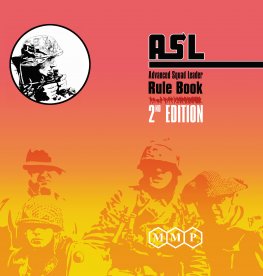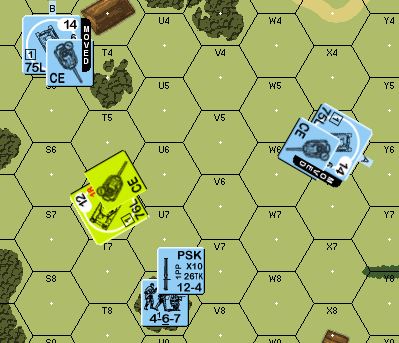
A recent discussion on the ASL forums delved into To Hit penalties incurred by a vehicle when changing Covered Arc to shoot enemy units. The discussion on the forums was short and I don’t believe it dug into the subject as deeply as it should. The discussion also highlighted the troubles new players have understanding this rule. In this article I am going to take a deeper look into the rule, provide a few examples, look specifically at an older Q&A, attempting to make this a little more clear.
Rules Dive

This article is specifically examining C5.12. It is a very short rule stating “The Case A DRM is applicable only to a Gun which made a CA change as part of its shot. If a Gun makes a CA change and fires with a Case A DRM and then fires again in the same phase, the Case A DRM will not apply unless it changes its CA again for the next shot.” For such a simple rule, a lot of confusion exists.
I think the source of that confusion is D3.51. I will not list that rule here but I suggest you take a moment to read it before continuing. The summarized juicy bits of D3.51 are this: once a weapon fires within the current CA, all other weapons pay the same Case A DRM, if a weapon elects to shoot outside the current CA, it only pays the Case A DRM for the last change. This last bit is the part introducing confusion. Nearly every such question I have seen on this topic comes back to this point.
Finally, D3.51 has a small tidbit about VCA changes. D3.51 states “If the VCA is changed … Any further changes of the TCA incurs normal TCA Case A DRM in addition to the NT Case A DRM of the VCA change …” Again, I encourage you to read the totality of the rule as I have excerpted the rule here for clarity. Let’s bring all of this together into a few examples and see how this all plays out.
Constraining The Examples
For these examples, assume no other DRM apply to the shots being discussed. I have multiple other articles covering all the DRM if you wish to see a more accurate accounting of ALL DRM. That is not the point of this article.
Example

Refer to Figure 1. It is the American Final Fire Phase. Having survived Prep Fire Phase, the American AFV opts to fire on German AFV A. There is no Case A DRM. This is the easiest example and perhaps too simple to even discuss but I include it for completeness.
If the American AFV instead opted to fire on German AFV B. They could change the VCA. As part of such change, the TCA remains relative to the VCA. The MA attack against Tank B receives a +3 Case A DRM. If the American tank instead opted to turn the TCA, the attack receives a +1 Case DRM. Again, these examples are fairly simple and do not involve multiple shots from the Americans.
Example 2

Now let’s look at something more complex. Refer to figure 2. It is the German MPh. The German player seeks to eliminate the American Sherman. First he moves tank A into position. Assume the American player changes TCA and shoots the MA. This change incurs a +1 Case A DRM. If the American opts to fire the CMG as well, this would suffer the same +1 DRM.
Now the German player moves Tank B into position. Recall, the TCA is now pointing at the U6/U7 hex side after the first shot. If the American player wishes to shoot the MA at tank B, he has to change the TCA two hex spines (to point at the S6/T5 hexside) incurring a +2 Case A DRM. Remember, only the last CA change applies to the shot (C5.12). Finally, the German player moved the squad/PSK into place. The American player fires the AAMG. Here, there is no Case A DRM. Unless the AAMG is in a fixed covered arc, Case A DRM are NA to an AAMG (D1.83)
Assume the American opts to change the VCA as part of the shot against tank A. The TCA remains relative to the VCA. The Case A DRM against tank A is +3. Now the German player moves tank B into position and the American player opts to pivot the TCA and fire against Tank B. The Case A DRM for this shot is +5. The VCA change still applies to the shot (D3.51). If the American player opts to fire the CMG as part of this, the same +5 DRM would apply.
The AAMG shot against the German squad is unchanged.
Even More Complex
Again, refer to Figure 2. The German player moves tank A into position. Again, the American player pivots the TCA to the U6/U7 hex side and shoots (+1 Case A). Now the German player moves tank B and the American player shoots. This time, the American player elects to spin the VCA. The TCA remains relative to the VCA so the American tank aligns its VCA with the S6/S7 hexside to bring the MA to bear. This incurs a +4 Case A DRM.
Accounting For ROF

Again, refer to figure 2. Assume the American player changes VCA to the U6/U7 hexside as part of its shot against tank A and keeps ROF. Assuming otherwise allowed, the Americans could fire again on tank A paying no Case A DRM (C5.12). Now the German player moves tank B into position and the American player turns the TCA to the S6/T5 hex side and shoots.This time, the Case A DRM is only +2 (remember, the TCA is initially aligned to the VCA pointing at the U6/U7 hex side). This is because C5.12 says previous DRM do not apply to a Gun taking ROF. If it opted to fire the CMG as part of this second MA shot, the CMG DOES pay the previous Case A DRM for the VCA change in addition to the new TCA change (+5 DRM).
An Old Q&A
There is an older v1 Q&A I wish to highlight.1(c) If an AFV has an AAMG with a restricted CA, does it have to pay Case A DRM for the AAMG fire? Does it matter if the AAMG is the MA? A. No. No. This Q&A directly contradicts newer Q&A and rule D1.83. I believe this is one of those v1 Q&A deprecated by introducing the v2 rule set. The v2 rules updated rule D1.83 to reflect this Q&A. As such, I believe we can ignore this Q&A and safely remove it from the Q&A collection.
Conclusion

I know it has been a while since I have written anything. I do have an article in the upcoming Journal 15. I have also updated another older article for inclusion in the upcoming Special Operations magazine. I was also pretty busy helping my friend finalize his scenario pack for publication and reviewing other articles for publication in other spaces. I have also been developing some scenarios of my own and coordinating some playtesting. All of this has kept me very busy.
Going forward, this is likely to be my new norm. Articles will be fewer and farther between as my attention is divided by more and more endeavors. I have a long list of articles I wish to write but there is only so much time in the day. I hope you understand. Have a good week.
Footnotes:
- 1(c) If an AFV has an AAMG with a restricted CA, does it have to pay Case A DRM for the AAMG fire? Does it matter if the AAMG is the MA? A. No. No.


Thanks for the article and your dedication to our game. Very informative and well-written.
Another great article. Brief, focused and to the point. And great examples.
Thanks, Jim!
Of note, I have cross posted this to Reddit/r/AdvancedSquadLeader
I didn’t know there was a sub reddit for ASL. Go figure. — jim
A missing example? Sherman turret pivots to fire MA at tank A, then the turret pivots again to fire the CMG at the PSK team. Is the Case A for the CMG +1 or +2?
Only the last applies. It would be +1 in that instance. Probably should have added this example too. — jim
These types of detailed discussion would do a great service to the ASL community at large if it were published in a tome as with the rules and Ch H…a book of detailed examples of complex situations with rules referenced throughout is sorely needed.
Not buying this statement, “Assume the American opts to change the VCA as part of the shot against tank A. The TCA remains relative to the VCA. The Case A DRM against tank A is +3. Now the German player moves tank B into position and the American player opts to pivot the TCA and fire against Tank B. The Case A DRM for this shot is +5. The VCA change still applies to the shot (D3.51).” If the American tank changed it’s VCA and fired at German tank A, that DRM is +3. Assuming he kept ROF, if tank B now moved into position, a TCA change by the American would only be +2 (not +5) because “If a Gun makes a CA change and fires with a Case A DRM and then fires again in the same phase, the Case A DRM will not apply unless it changes its CA again for the next shot.” Unless he didn’t fire the MA against tank A (say he fired the CMG instead), he would not be penalized for his MA shot at tank B.
I *think* you’re saying that if a tank changes VCA to take a shot (the TCA remains fixed relative to the VCA) and then later changes TCA to fire the at another target, only the TCA change applies. If that’s what you’re saying, then I direct you to D3.51:
… If the VCA is changed, the TCA changes the same number of hexspines while retaining its position relative to the VCA. Any further changes of the TCA incurs normal TCA Case A DRM in addition to the NT Case A DRM of the VCA change [EXC: Bounding First Fire does not pay CA change DRM (C5.13) nor does it prevent further changes in TCA/VCA]. …
ROF on the MA would “reset” everything to +0 and negate past DRM for the MA. That “reset” is less clearly outlined in the ASLRB. That’s in C5.12, although it uses “shoots again in the same phase” rather than stating “uses ROF/IF”. — jim
It could be you’re saying suppose that the American tank changed VCA to shoot the MA and maintained ROF. Then it turns to shoot at tank B, this second shot would only be +2, e.g. the VCA would not apply to this second shot. I agree with that, but the example said nothing about ROF in this instance. ROF and its affects is covered in the next section. — jim
Hey Jim (and Rick)
Great article by way.
I have to say based on the wording of the example I am with Rick here (i.e. in relation to “Now the German player moves tank B into position and the American player opts to pivot the TCA and fire against Tank B. The Case A DRM for this shot is +5. The VCA change still applies to the shot (D3.51).”)
Jim, I think you clarified your intent with the comment above (which I agree with and I feel Rick would too based on my reading of his comment), however, I feel the wording of the example and your clarfication are at odds with each other and the example needs updating.
In short, the Case A +3 for the VCA change is applicable in addition to any TCA change Case A modifications relative to the VCA, for that MA shot only. Further Case A modification for changes to VCA/TCA for subsequent MA shots (at Tank B in the example) would be relative to the VCA/TCA for the shot just taken (at Tank A in the example).
I will note that if the ‘shot’ at tank A is with the CMG only, then I might be inclined to agree with you Jim, but I think that is another edge case.
Hopefully the above is clear.
Tim
The example as written holds together. I am sure we could both come up with additional situations where the words on paper would have to be changed to describe the new situation.
All of these examples are contrived to make a point. That’s the nature of examples. I try to make them game relative as best I can.
Jim
In reading D3.51 prompted by your article, I was surprised to find the wording that allowed further TCA change “preceding shot(s) were taken at a Known enemy unit; otherwise no further
change in TCA is allowed during that phase.”
I am interpreting that ‘Known’ relates to the moment the shot is taken, and not ‘Known’ after the shot was taken. Also of interest is whether the use of ‘shot(s)’ here means that (for example) a shot could be taken with a CMG at an Unknown unit, resulting in it being Known, and that as long as another turret mounted weapon then fires at that now Known unit, it would be free to later turn it’s TCA to fire again (e.g. assuming a MA ROF).
Thoughts?
Tim
I left this out of the example because I have seen two trains of thought.
1) If the enemy is Unknown at the moment of declaring the shot, no other CA changes are allowed. I favor this interpretation and I think this is most supported by the rules as written.
2) If the enemy becomes known as a result of the shot, then you can continue to change CA as desired.
The rule as written says you cannot change the TCA again if any previous shots were against an unknown unit. Since the TCA stays relative to the VCA, this also implies no further VCA changes. So in your example above, I would deny the TCA change. Subsequent shots against known enemy units do not matter. — jim
Thanks Jim, that makes sense. Appreciate the response.
Thanks Jim, both for your follow up and great work here.